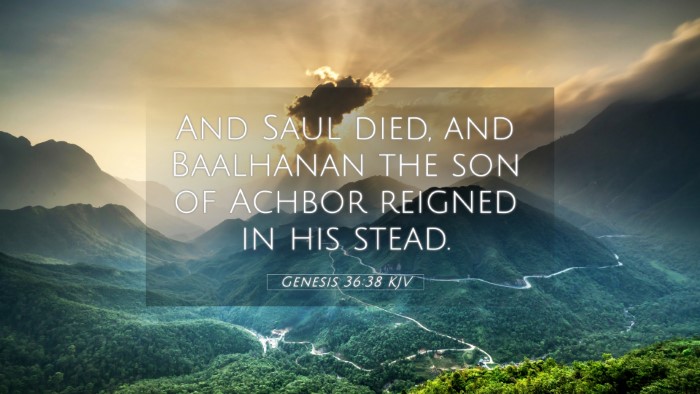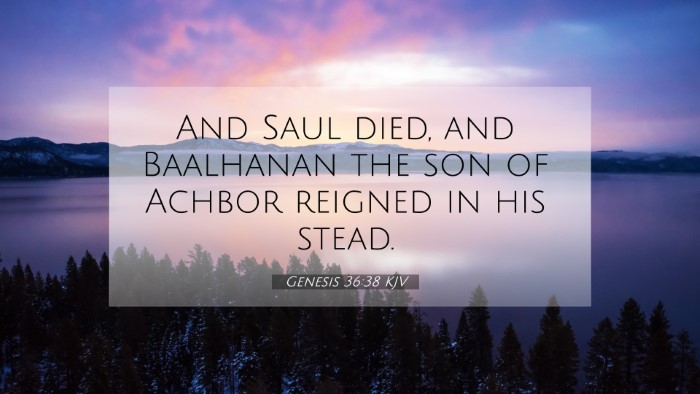Understanding Genesis 36:38
Genesis 36:38 reads: "And Shaul died, and all the men of his house were buried in the city of Hebron." This verse marks a pivotal moment in the historical lineage of Esau, tracing the descendants of the Edomites.
This passage emphasizes the theme of mortality and legacy, which is evident through the death of Shaul and the subsequent burial of his lineage in Hebron. Commentaries have elaborated on the implications of this verse, providing deeper insights into its theological and historical significance.
Commentary Insights
-
Matthew Henry's Commentary:
Henry emphasizes the importance of heritage and the significance of burial sites in biblical times. He notes that the men of Shaul's house were buried where their ancestors resided, indicating a continuity of family tradition and reverence for historical roots.
-
Albert Barnes' Commentary:
Barnes comments on the significance of Hebron as a burial site, linking it to its earlier biblical importance as the location of Abraham's burial. This connection reinforces the relational ties among the patriarchs and develops the interwoven family history.
-
Adam Clarke's Commentary:
Clarke provides contextual background about the descendants of Esau and identifies Shaul's death as part of the transition period in Edomite history. This aligns with broader themes present in the narrative of Esau's lineage, revealing the fluctuation between prosperity and decline.
Key Themes
- Heritage and Lineage: The verse speaks to the importance of kinship and the continuation of family lines, reflecting the broader biblical theme of God’s promises to Abraham and his descendants.
- Burial and Memory: By highlighting the burial place, the verse invites readers to consider the cultural significance of burial practices and remembrance of ancestors in biblical times.
- Continuity of History: The genealogical emphasis in this chapter connects the past to the present, illustrating how the narrative is constructed to maintain continuity in the history of Israel and its relatives.
Bible Cross References
This verse is connected to several significant passages throughout the Bible that further illuminate its meaning:
- Genesis 23:19: The burial of Sarah in Hebron highlights the importance of this city as a revered burial ground.
- Genesis 25:9: Refers to the burial of Abraham, tying the importance of family and ancestry to Hebron.
- Numbers 20:29: The death of Aaron and subsequent mourning emphasizes the loss of leadership and the transition of authority.
- Joshua 14:13: Caleb receives Hebron as a city due to his faithfulness, linking the location to blessings and legacy.
- 1 Chronicles 2:50-51: Lists the descendants of Esau, establishing the genealogy that includes Shaul.
- 2 Samuel 5:1-3: Connects the city of Hebron to King David, showing its significance in the larger narrative of Israel's kings.
- Romans 5:12: Discusses death entering the world through one man, referencing the widespread theme of mortality and legacy throughout the Bible.
- Psalms 49:16-17: Reflects on the fate of the wise and the foolish in death, echoing themes of human mortality similar to that of Shaul.
- Hebrews 7:14: Highlights the significance of Judah and its lineage, bridging connections back to the broader family line of Abraham.
- Revelation 21:14: References the names of the twelve tribes, reminding readers of the lasting identity and heritage stemming from these early patriarchs.
Connecting Themes Across the Bible
The examination of Genesis 36:38 in light of these cross-references encourages a deeper understanding of the Biblical narrative and its interconnectedness:
- The pivotal moments of death and burial reflect God's covenant with His people and the enduring significance of their legacy.
- Connections between families and their burial sites reveal profound insights into communal memories and identities throughout scripture.
- The theme of mortality is prevalent, urging believers to reflect on their life’s purpose and legacy in light of God’s kingdom.
Concluding Thoughts
In conclusion, Genesis 36:38 serves as a significant verse in the larger biblical narrative, addressing themes of lineage, mortality, and the impact of legacy. By cross-referencing with other scriptures, we can see how interconnected the stories of the Old Testament are, enriching our understanding of God’s eternal plan for His people.


